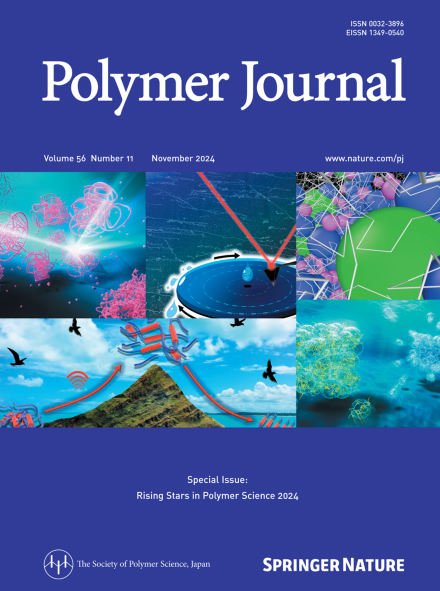Synthesis and characterization of ester-free poly(trimethylene carbonate) bearing long-alkyl moieties and its degradation
IF 2.3
4区 化学
Q3 POLYMER SCIENCE
引用次数: 0
Abstract
Compared with ester derivatives, ester-free poly(trimethylene carbonate) (PTMC) derivatives have attracted increased interest because they do not create any acidic compounds after decomposition. Inspired by the chemical structure of poly(α-olefin)s or branched polyethylene (PE), various lengths of alkyl chains, such as -C8H17, -C12H25, -C16H33, -C18H37, and -C20H41, were introduced into trimethylene carbonate (TMC) with ester-free structures to improve the physical properties of PTMC, which can be labeled with trimethylolethane. These monomers were polymerized, and their thermal properties, hydrophobicity, and degradation behavior were investigated. When the length of the alkyl chain was longer than -C16H33, the polymer solidified with higher melting points than at room temperature. The poly(trimethylene carbonate) (PTMC) derivative with a -C18H37 group at the side chain was used for the hydrolysis test both in organic and aqueous solvents, resulting in 91% degradation after 9 weeks in a mixture of THF-d8, D2O, and NaOHaq at room temperature, whereas only 11% degradation was observed in NaODaq. after 9 weeks, suggesting that the hydrophobic long alkyl chains at the side chains influenced their hydrophobic nature and degradation manner. Various lengths of alkyl chains, like -C8H17 to -C20H41, were introduced into trimethylene carbonate (TMC) to enhance the physical properties of ester-free poly(trimethylene carbonate) (PTMC). The resulting polymers were studied for their thermal properties, hydrophobicity, and degradation behavior. Solidified PTMC was achieved with alkyl chains longer than -C16H33 and had melting points above room temperature. PTMC derivative with a -C18H37 group side chain showed 91% and 11% degradation after 9 weeks under organic and aqueous condition, respectively, suggesting that the long alkyl chains influenced its hydrophobic nature and degradation behavior.

含长烷基基团的无酯聚碳酸三甲酯的合成、表征及其降解
与酯类衍生物相比,无酯的聚碳酸三甲酯(PTMC)衍生物由于其分解后不产生任何酸性化合物而引起了人们越来越多的兴趣。受聚α-烯烃或支链聚乙烯(PE)化学结构的启发,在无酯结构的碳酸三亚甲基(TMC)中引入不同长度的烷基链,如-C8H17、-C12H25、-C16H33、-C18H37和-C20H41,以改善PTMC的物理性能,可以用三甲基乙烷进行标记。对这些单体进行了聚合,并对其热性能、疏水性和降解行为进行了研究。当烷基链长度大于-C16H33时,聚合物凝固时熔点高于室温。侧链上有-C18H37基团的聚碳酸三甲酯(PTMC)衍生物在有机溶剂和水溶液中进行了水解测试,在室温下,在THF-d8、D2O和NaOHaq的混合物中,9周后降解率为91%,而在NaODaq中仅观察到11%的降解。9周后,表明侧链上的疏水性长烷基链影响了它们的疏水性和降解方式。在碳酸三亚甲基(TMC)中引入-C8H17 ~ -C20H41等不同长度的烷基链,以提高无酯聚碳酸三亚甲基(PTMC)的物理性能。研究了所得聚合物的热性能、疏水性和降解行为。当烷基链长度大于-C16H33时,PTMC的熔点高于室温。具有-C18H37基团侧链的PTMC衍生物在有机和水条件下,9周后降解率分别为91%和11%,表明长烷基链影响了其疏水性和降解行为。
本文章由计算机程序翻译,如有差异,请以英文原文为准。
求助全文
约1分钟内获得全文
求助全文
来源期刊

Polymer Journal
化学-高分子科学
CiteScore
5.60
自引率
7.10%
发文量
131
审稿时长
2.5 months
期刊介绍:
Polymer Journal promotes research from all aspects of polymer science from anywhere in the world and aims to provide an integrated platform for scientific communication that assists the advancement of polymer science and related fields. The journal publishes Original Articles, Notes, Short Communications and Reviews.
Subject areas and topics of particular interest within the journal''s scope include, but are not limited to, those listed below:
Polymer synthesis and reactions
Polymer structures
Physical properties of polymers
Polymer surface and interfaces
Functional polymers
Supramolecular polymers
Self-assembled materials
Biopolymers and bio-related polymer materials
Polymer engineering.
 求助内容:
求助内容: 应助结果提醒方式:
应助结果提醒方式:


